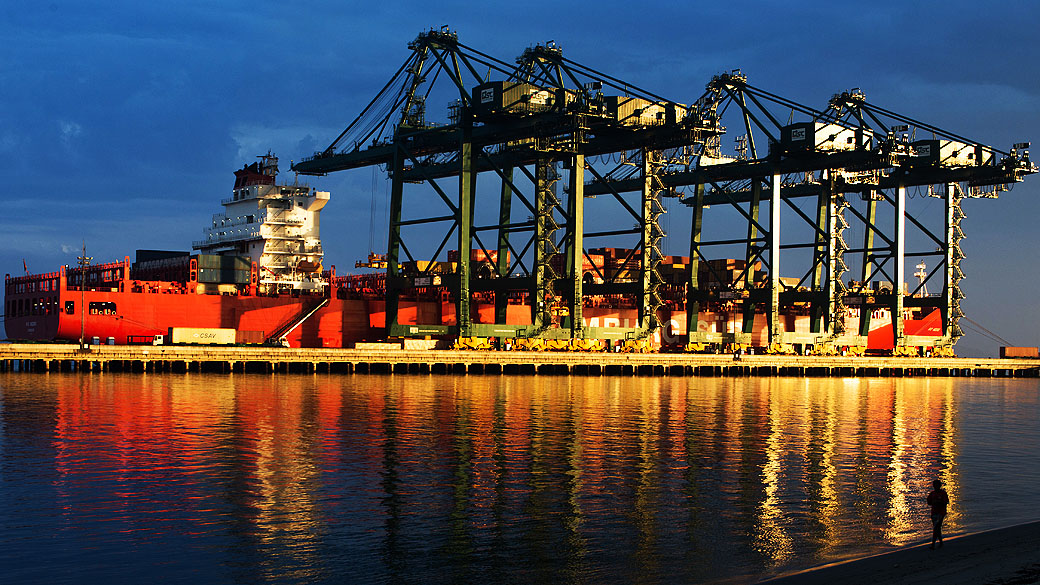President will have to deliver a more competitive country in her second mandate
There is no free lunch: without the commodities 'boom' and help from China, productivity will have to advance if Brazil is to return to growth

The Brazil that emerges from the elections has one imperative need if it is to start growing again: gaining productivity. Over the last four years the government has not managed to resolve the grave problems of the Brazilian economy, such as the high and complicated tax burden, the low level of infrastructure and the lack of skilled labor. In some aspects, the business environment has actually worsened, with the government using an interventionist policy in sectors such as autos, oil and gas, and electricity. The result is that Brazil registered an accumulated negative performance in the three years between 2011 and 2013, in the productivity indicator drawn up by the Conference Board. To reverse this situation, Dilma Rousseff´s second government will have to introduce policies that go in the opposite direction of those implemented in recent years. The key, according to specialists heard by the VEJA site, is to switch from ideology to meritocracy. The pursuit of more strategic commercial markets is the first step.
Abandoning protectionism in sectors that are uncompetitive comes next. The mission is difficult. Rousseff has not given any sign of making a change yet but she will have to examine her conscience which could lead to the realization that the protectionist measures that have marked her government have rebounded and led the country to low growth.
Specialists consulted by the reporting team are categorical: if Brazil is to make a genuine leap forward in productivity, its industry will have to become part of the global value chains, i.e. operate with prices and quality to compete with other countries. This mission will only be possible if the reelected president makes it a priority, along with advances in public health and education. For this to come about, the investment rate/Gross Domestic Product (GDP) ratio will need to rise. Brazil registered its lowest ever investment rate during the Rousseff government, of 18%. In Latin American countries like Peru, Chile and Mexico, this ratio comes to an average of 25%. In China, it is around 30%. “We have made no progress due to the current government´s ideological positioning. Instead of looking for more demanding and profitable markets, the focus was on the Mercosul – a free trade area involving Brazil, Argentina, Uruguay, Paraguay and Venezuela – and was a disaster. Exports to Argentina have been falling and China is increasingly winning more market share at our expense,” said Luiz Felipe D’Ávila, president of the Public Leadership Center (local acronym CLP).
Brazil has longstanding problems that have held back its development and have still not been properly resolved: deficient infrastructure, much higher taxes than its neighbors, and bureaucracy. Furthermore, there has been a distancing from the business sector during the Rousseff government which was one of the main reasons why the industrial sector has underperformed. This does not mean that Rousseff did not want to go forward. Initiatives like the “Brasil Maior” Plan and the payroll tax exemption package show the contrary. The problem is that the government´s concept of how to make the country more competitive is far from the real experience undergone by countries which set an example, such as South Korea. The government measures made industry more domestically focused and reduced its potential to be competitive during a period in which Brazil most needed the sector to grow. “The government has to recognize the importance of industry through a national development project. It is not enough for industry to be competitive within its own borders,” said Paulo Francini, Economy director of the São Paulo State Federation of Industries (Fiesp).
As a result of the protectionist measures on the market, productivity has made a lower contribution to Brazil´s economic growth than in other countries. The indicator of the Organization of Economic Cooperation and Development (OECD) which calculates the total factor productivity (TFP) shows that Brazil´s average annual “growth” from 2000 to 2012 was negative at 0.3%. In the case of the 10 most developed Latin American countries, the average rate over the same period showed a rise of 0.14%. When we look at the average performance of seven Asian countries, we see an expansion of 2.4% in productivity. Confirmation of this scenario is seen in the difficulty involved in opening and closing companies in Brazil. The World Bank´s Doing Business indicator shows that opening a company in Brazil requires 13 steps and takes 119 days. The same process can be achieved in just 14 days in Chile, Colombia and Mexico.
Specialists agree that the only way to rescue the country from a model that discourages competing abroad is to establish horizontal policies, i.e. policies that are the same for all sectors. This approach is exactly the opposite of what is being applied under the present government. In an attempt to boost employment, the government ended up forcing consumers to buy goods produced at home rather than imported products at more competitive prices. By doing so, it created a chain of inefficiencies, nurtured by high prices. “The best thing the government could do is to create the right conditions for productivity to grow instead of making risky bets on specific sectors,” said Jens Arnold, a senior OECD economist.
Should Rousseff´s strategy not include any plan for an effective industrial opening which prepares Brazil to meet global demands, the country may not only become less competitive than other states but also in relation to itself. Economist Carlos Arruda, coordinator of the innovation center of the Fundação Dom Cabral business school, said the productivity gains of those sectors that manage to advance usually originate from an increase in investment and the production area and not from productivity, as such, which involves innovation and technology. Another deficiency is that even in the case of competitive sectors, such as agribusiness, the inefficiencies that exist along the road until the product reaches the final consumer end up cancelling out the gains obtained from the innovation. “There was a gain in production and efficiency in the agricultural sector, particularly per hectare of soybeans. However, by the time the product reached the end consumer, this gain in production had been cancelled out along the stages of the chain through productive inefficiencies linked to infrastructure, logistics, suppliers, services and distributors,” Arruda said. Embraer, a company that works with productivity gains, finds itself trapped in this same situation. It gives its employees regular training in pursuit of efficiency gains but receives the productive deficiencies of its suppliers. “These are productive legacies. The problem does not lie in the macro or micro area alone. A chain lies between the two that incorporates or removes productivity from the productive process,” he added.
Maintaining employment has been upheld by the government as a reason for all the industrial protectionism policies. President Rousseff´s intention has always been very clear: she believes a heated consumer market means industry will not have to fire workers. Moreover, if this industry used domestically-produced goods, it would end up creating a virtuous cycle of employment and consumption. However, the president forgot to agree on this point with the Brazilian people whose budgets are being squeezed by debt. If industry was more competitive, it could offset the domestic cooling by exporting. The biggest example of the failure of this strategy can be seen in the sector that received the lion´s share of stimulus measures – the auto sector. This is exactly the sector that has been most hit by the effects of the slowdown. Vehicle sales have registered a record accumulated fall for this decade and over 10,000 car workers have already been dismissed this year. Backtracking along this road in pursuit of genuine trade opening means winning in the long term. Specialists say the result will be a country with a more sustainable and less unstable job market — as it will not be directly dependent on government policies. The recipe is above party politics and pragmatic. However, it needs a skilled cook.
How to restore productivity…
In the sugar-alcohol sector
Increased productivity in the sugar-alcohol sector is directly linked to investment in innovation such as, for example, more efficient seedlings. Experts say new seedlings have a genetic potential that is 13% more productive if handled correctly. They recommend that 20% of the crop be renewed annually so that all the seedlings will have been replaced by more productive varieties within five years. However, the lack of cash means that the Brazilian sugar mills usually only renew 10%. The result was a loss of productivity of around 5% between 2006 and 2013. In comparative terms, soybeans and corn expanded by 2% and 36% in the same period, respectively. Better quality seedlings are the result of billion dollar investments in innovation. In this case, there is no doubt that the producers are at a disadvantage. While the big grain producers can rely on the support of the official agricultural research body Embrapa and giants like Monsanto and Cargill to finance better genetics, innovation in the case of sugar cane is left to a group of indebted producers. It is also worth recalling that the government has also made the situation worse by keeping gasoline and diesel prices suppressed over the last two years. This decision meant the mill owners were unable to pass on their higher costs in the price of the product and also take on heavier investments in innovation and the proper management of cultivating the crop.
In the oil and gas sector
Productivity in the oil and gas sector has two important aspects: geological and industrial. The number of barrels produced per worker, for example, varies according to the field explored. It is a sector where it is difficult to measure productivity by parameters although there have been some initiatives to standardize the metrics. Even then, one does not need to be a great expert in the area to know that Brazil faces a major challenge with the pre-salt layer discovery. Investments for exploring wells cost billions of dollars and the domestic industry still does not have the right level of competitiveness to meet this growing demand ahead. As a result, progress in the sector will require some flexibility in buying products and contracting services. For a chain that lacks important elements, imports do not mean lower job creation but are a way of overcoming the excess amount by domestic producers, which directly impacts production and productivity. Petrobras, for example, the biggest company in Brazil in the sector, complains that it cannot meet its investment timetable because domestic industry cannot match demand. The local content policy in this situation is more of a hindrance than a driver of development. “The local content policy needs to become more sophisticated. Instead of replacing imports indiscriminately, some sectors should be allowed to import and export,” said Edmar de Almeida, research director of the Economic Institute of the Rio de Janeiro Federal University (UFRJ). João Almeida, a lawyer in the oil and gas sector in the Demarest Advogados law firm, said one solution could be if the National Petroleum and Gas Agency (ANP) were to give specific permits that would allow the companies to be more flexible, within a pre-established limit, in terms of the targets for local content that were agreed in the bidding processes. “There is room within the interpretations of the regulations to make them more flexible,” Almeida said.
In the electricity sector
Efficiency is the key word when productivity is mentioned in terms of the electricity sector and reinforces the need for a commitment from the next government to boost it. The regulatory turnaround in 2012 brought about by Provisional Decree 579 that ensured the charge should be affordable, squeezed the revenues of the companies in the sector. The decree foresees the generators and distributors being remunerated for their operating costs and not for their investments in improving efficiency. “For those companies which accepted the new rules, this was a return to 1998 when the charge was to cover the operating costs, not the efficiency,” said Alexei Ivan, president of the Brazilian Electrical Energy Association (Abee). The problem was that the companies have seen their costs shoot up in the last two years with the fall in the level of the hydroelectric reservoirs and the switching on of the thermo-electric plants, the production costs of which are significantly higher. The result of this situation was that the infrastructure started to become obsolete and investments in efficiency dried up. To gain efficiency, specialists in the sector recommend, amongst other things, investments in generation, particularly in hydroelectric plants with large reservoirs, reducing the technical and non-technical losses from transmission and distribution lines, respecting contracts, legal security and regulatory stability.
In the automotive sector
Boosting productivity in the auto sector involves two main obstacles: the copying type of profile and belief in scale. Manufacturing in Brazil has always copied models created in intelligent and innovative centers based in Europe, the United States, South Korea, China and Japan. Brazilian industry only carries out the processing which does not bring changes at technological and design level, apart from some adaptations. The belief in large-scale production exists in Brazil, i.e. producing a large volume of few models in a bid to keep costs low. “The companies´ thinking is that, in plants like the Brazilian ones, the bigger the scale, the better,” said Luiz Carlos Mello, former president of Ford Brasil and partner director of the Center of Automotive Studies (CEA-Autodata). The New Auto Law System, set up by the current government, brought some more modern plants to the country but most automakers still have old-fashioned plants that need to be adapted to the production of fewer and more modern models. Another factor is the Brazilian auto industry´s bias towards the domestic market. “We do not have a tradition of creating world trends and working brands. The auto plants need to be more flexible to become a benchmark, as in South Korea,” said Mello. The average production of cars per employee per year is 83 in the United States compared with 23 in Brazil, according to figures from 2013. Despite this, there certainly have been gains in productivity over the last two decades. Domestic production jumped from 1.4 million to 3.5 million vehicles in this period with the same workforce. However, this advance was due mainly to increased capacity through expanding plants and not by investing in innovation, research and development, and education.
In infrastructure
Brazil´s poor infrastructure has long been a topic for discussion. Despite this, little progress has been made in recent years. The regulatory insecurity, the lack of proper maintenance of the existing projects, the lack of any connection between the transport models (highways, railroads, waterways and airports) has hit profitability and increased the “Brazil cost”. The square kilometer area/rail kilometer ratio shows Brazil has a proportion of 286, compared with 19 in Japan, 42 in the United States, 51 in India, 111 in Argentina and 201 in Russia. The lower the number, the better, according to a survey by the International Union of Railways. Logistic specialists say the country is a long way from being able to meet all the needs, particularly in terms of railroads which are cheaper for exporters. A train can transport 100 tons per wagon. As each train has an average of 30 wagons, it can transport 3,000 tons at a time. The standard truck carries only 30 tons. Despite this, the railroad network is old and trains cannot move at high speed, as in other countries. “Brazilian railroads do not have the capacity to meet the demand. Many companies would like to use this transport model but do not have access to it,” said Paulo Fleury, general director of the Ilos consultancy. As railroads are in a sector that requires high investment, government subsidies, such as lower interest rates, would encourage private investment. The current government launched a program in 2012 to change the regulation of the sector and build 11,000 kilometers of railroad track. However, nothing has come off the drawing board to date. The uncertainty in relation to the new regulatory model for the sector has held up investments. In the case of waterways, it is the same old story: the water potential is wasted. A survey by Ilos shows there are more than 40,000 kilometers of waterways available, particularly in the North and Midwest regions. The ports have also being hit by the legal uncertainty brought about by the change in the regulatory system introduced last year. The tender conditions for the first concessions for the new model have still not been approved. The first step the next government should take, according to the experts, is to carry out a broad diagnosis of the state of the works and the projects that are on their way. Priorities then need to be established and a timetable drawn up for the projects to advance. The quality of the engineering projects that have already been made also needs to be considered and, if necessary, redone. Planning should occur at the same time as the exponential growth in demand, a condition needed for the development of any country.


 SEGUIR
SEGUIR
 SEGUINDO
SEGUINDO

 Shopping se manifesta sobre ‘calote’ de Taís Araújo
Shopping se manifesta sobre ‘calote’ de Taís Araújo Ivanir dos Santos entra com representação contra Ludmilla: ‘É crime’
Ivanir dos Santos entra com representação contra Ludmilla: ‘É crime’ Mulher de Jeff Bezos quebra protocolo em festa na Casa Branca
Mulher de Jeff Bezos quebra protocolo em festa na Casa Branca Dívida de Taís Araújo em condomínio vira caso de Justiça
Dívida de Taís Araújo em condomínio vira caso de Justiça Os achados da nova rodada de escavações no sítio arqueológico de Pompeia
Os achados da nova rodada de escavações no sítio arqueológico de Pompeia







